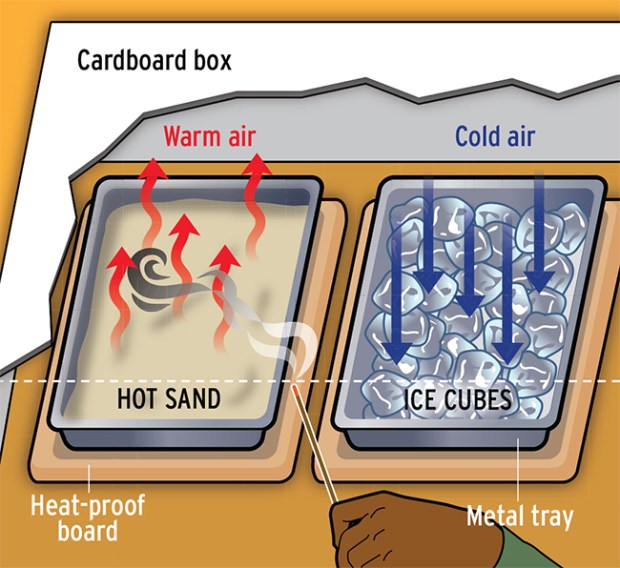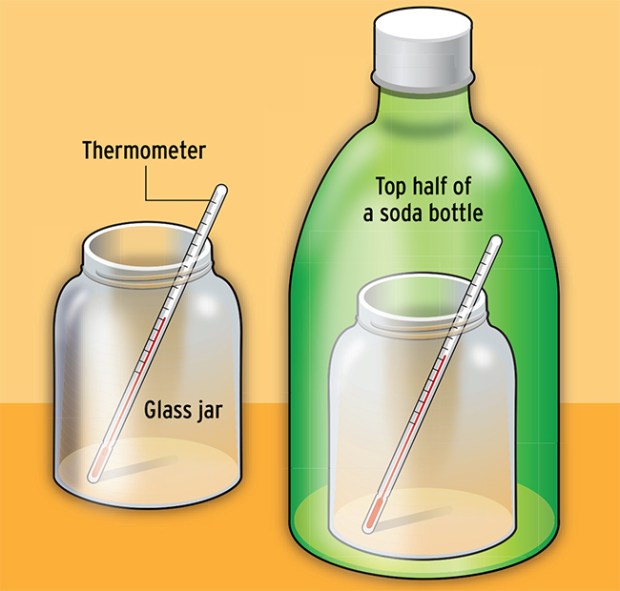4 interesting weather experiments to try at home
Learn about science, weather and energy by conducting these experiments with easy-to-find materials.

CREATE A TORNADO
Materials:
- Tall drinking glass
- Bottle of clear soda or carbonated water
- Table salt
- Long stirrer
Steps:
- Pour the soda or water into the glass until it is 2/3 full.
- Use the stirrer to stir the liquid as fast as it can go without spilling over the top, then pour some salt in it.
- Watch the resulting carbon dioxide bubbles form a tornado.
Conclusion:
Tornadoes are formed when warm, moist air swirls together with cool, dry air. They are most often associated with storm clouds that contain vortexes — spirals of rising air. As the vortex sucks in the surrounding air, more air moves in at a high speed to fill the space.

CREATE A BREEZE
Materials:
- Two metal baking pans
- Two heatproof pads or boards
- Oven mitt
- Large cardboard box
- Dry sand
- Ice
- Incense stick
- Scissors
- Matches
Steps:
- Fill the first pan with sand and place in an oven on the lowest heat setting.
- Use the scissors to cut off the front of the cardboard box. Place the heatproof pads or boards nextto each other inside the box.
- Fill the second pan with ice and place it on one of the pads. Wait several minutes for the first pan to “cook,” then use the oven mitt to remove it from the oven and place it on the pad next to the pan of ice so that the two pans are practically touching.
- Light an incense stick and hold it horizontally, with the burning tip right between the two pans. Smoke from the stick will always drift toward the warm pan full of sand.
Conclusion:
The pan full of ice cools the air above it, causing the air to sink. The pan full of warm sand warms the air above it, causing the air to rise. This creates a low-pressure zone just above the sand, and the air above the ice will rush in to equalize the pressure. This is how a breeze works. For example, on warm summer days, land heats up faster than water, so the cooler air above lakes and seas often rushes toward land to create a breeze.

MEASURE WIND SPEED
Materials:
- Paper plate
- Four paper cups
- Colored tape
- Thumbtack with plastic end
- Pencil with an eraser
- Double-sided tape
- Stopwatch
Steps:
- Mark one paper cup by wrapping the colored tape around the outside.
- Use the pencil to draw an “x” on the plate, with the middle of the “x” as close to the middle of the plate as possible.
- Attach a short length of double-sided tape to the side of each cup. Attach one cup to the edge of the plate with the opening facing left. Rotate the plate and attach the rest of the cups the same way.
- Punch the thumbtack through the middle of the plate on the “x.” Pin the plate to the eraser and hold up the plate and cups so they may spin in the breeze.
- Find a Web site that gives you the wind speed in your area. Count how many times the marked cup goes around in 30 seconds and write it down. Repeat the process at different times over several days, and you’ll be able to translate your numbers into wind speeds. Soon, you won’t need to check with the Internet anymore.
Conclusion:
An anemometer is an instrument that measures the speed of the wind. A professional anemometer uses spinning discs linked to an electronic device that counts the turns and converts them into wind speeds.

THE GREENHOUSE EFFECT
Materials:
- Tall plastic soda bottle
- Glass jar small enough to fit inside the bottle
- Scissors
- Thermometer
Steps:
- Use the scissors to cut the bottom off the plastic bottle. Remove the label, but leave the top on.
- Stand the thermometer inside a jar, place it in a sunny spot, and check the temperature in an hour.
- Put the bottle over the jar and leave it for another hour. Check its temperature, and compare with the earlier temperature.
Conclusion:
The second temperature is considerably warmer than the first. That’s because the solar energy passing into the bottle has been turned into heat that can’t escape. The earth’s atmosphere serves a similar function as the bottle — it allows the sun’s energy to pass through, then keeps it from escaping into space.
Find these experiments, and more like them, in “Weather Watcher,” a DK Nature Activities book, DK Publishing, $9.99, dk.com.
The experiments listed are for younger kids, so I would advise those wanting more to find out about erosion experiments and things like the flower ( used in cooking) avalanche.
very fun stuff
what would happen if you put diffrent water colors in water wiht a plant inside.
this is cool
I think that it needs more experiments.
cool
these are realy cool
Its cool you could print it and bring it in to school.
This Rocks!
these are more for the younger grades Past 6th, you do all of these
Can they please make something for 6th grade and above because i need 10 points or more to pass science our whole 5th through 8th hate science its the only one people fail in
I don’t know y u all like science i need 10 or more points to pass and i am about the 5th smartest kid in my class.